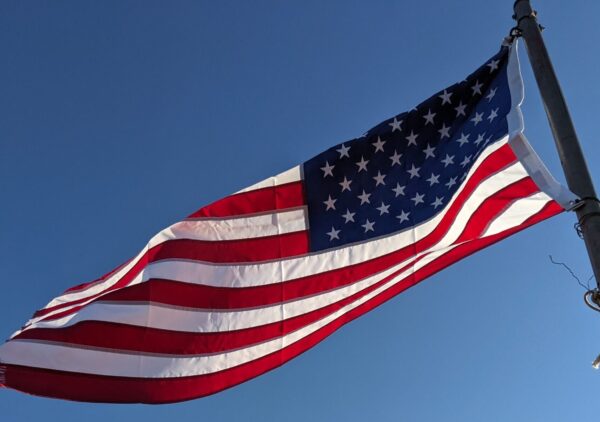The biggest and best flag that ever flew was created by Mary and Caroline Pickersgill. Although Caroline was just a young girl, her mother, Mary, taught her how to sew flags. Mary made flags for a living, as Caroline’s father had died.
Soldiers from Fort McHenry came to Caroline’s house to ask her mother to make the biggest and best flag to fly over Fort McHenry. This flag was to have fifteen stars and fifteen stripes to represent the first fifteen states to join the Union.
The soldiers wanted the biggest flag ever made so that people could see it from far away and know that Baltimore was safe.
Mary, Caroline and her grandmother, Rebecca Young, started immediately on the flag using the widest cloth they could find. Mary wove the stars herself as they wanted them even wider.
There was not enough room in their home to put the flag together, so they laid it out in the tavern down the street and sewed it together there.
When they finished the flag, it weighed 50 pounds and was 30 feet wide and 42 feet long.
The soldiers took the flag to Fort McHenry, pleased that everyone in the area would be able to see the flag.
Caroline could see the flag flying from her upstairs window three miles away from Fort McHenry. She was sure it was the biggest and best flag ever made.
The War of 1812 had everyone afraid. The British had just captured Washington. They burned the White House and the Capitol building. Most people expected them to attack Baltimore next, and they did.
Mary and Caroline could see the ships firing on Fort McHenry. The soldiers at the fort fired back. Many of their neighbors packed what they could and left. Mary, Caroline, and Caroline’s grandmother stayed in their house on Albemarle Street. As the battle raged on through the night they looked out to see if the flag was still there. They could not see, but in the morning as they hurried to the window, they could see their flag was still flying.
Someone else could also see that the flag was still flying. A young American lawyer named Francis Scott Key had also watched for the flag, and he wrote a poem about that flag.
Oh, say can you see by the dawn’s early light, What so proudly we hailed at the twilight’s last gleaming? Whose broad stripes and bright stars through the perilous fight, O'er the ramparts we watched were so gallantly streaming? And the rockets’ red glare, the bombs bursting in air, Gave proof through the night that our flag was still there. Oh, say, does that star-spangled banner yet wave O’er the land of the free and the home of the brave!
This poem later became our national anthem. We all want to honor our flag.
Today the biggest and best flag is the biggest and best exhibit in the Smithsonian Institution in Washington, D.C.
As we honor our flag this week let us remember some of the basic rules of flying a flag.
- All flags should be respected and flown with dignity and honor.
- When a flag is worn it should be disposed of properly.
- Flags flown at night should be lit.
- Flags should never touch the ground, the floor, water, or merchandise.
- The flag should not be flown in inclement weather.
- The flag should never be carried flat or horizontally, but always aloft and free.
- The flag should never be fastened, displayed, used, or stored where it might be easily torn, soiled or damaged.
Fly our flag proudly.
– by Elaine Baldwin
Feature image caption: The American flag flies over Cannonville on June 30, 2023.
Elaine Baldwin – Panguitch
Elaine Baldwin is an Editor/Writer for The Byway. She is the wife of Dale Baldwin, and they have three children, 11 grandchildren and one great granddaughter. Elaine enjoys making a difference in her world. She recently retired after teaching Drama for 20 years at Panguitch High School. She loves volunteering and finds her greatest joy serving in the Cedar City Temple each Friday.

